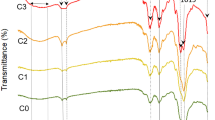Abstract
Poly(D,L-lactic-co-glycolic acid) (PLGA) has been widely used as a biodegradable polymer in the fabrication of porous polymer scaffolds, but it is hydrolyzed into acidic by-products such as glycolic acid and lactic acid in the human body. Magnesium hydroxide nanoparticles (Mg-NPs) were incorporated into a PLGA scaffold in order to neutralize the acidic environment caused by the hydrolysis of PLGA, thereby reducing the cytotoxicity and inflammatory response. In this study, three-dimensional porous scaffolds blended with 30% Mg-NP were fabricated using gas foaming (PLGA/Mg/NaHCO3), salt leaching (PLGA/Mg/NaCl), and freeze drying (PLGA/Mg/Ice), and their structures, morphologies, pH change, thermal properties, and mechanical properties were analyzed by Fourier transform infrared spectroscopy, scanning electron microscopy, pH meter, thermogravimetric analysis, and a universal testing machine. The porosity of the PLGA/Mg/Ice scaffold was higher at about 10-13 wt% than those of the PLGA/Mg/NaCl or PLGA/Mg/NaHCO3 scaffolds. The Mg-NP content of the PLGA/Mg/NaHCO3 scaffold remained lower than those of the other scaffolds at about 63%. As a result of this loss of Mg-NP, the PLGA/Mg/NaHCO3 scaffold was confirmed to have lower cell viability (about 70%) than the PLGA/Mg/Ice scaffold (about 100%), owing to the reduced neutralizing effect. Although the PLGA/Mg/Ice and PLGA/Mg/NaCl scaffolds showed similar cell viability, the NaCl of the PLGA/Mg/NaCl scaffold exhibited slight toxicity in the body. The expression level of interleukin-6 (IL-6) was significantly decreased in the PLGA/Mg/Ice scaffold than in the PLGA/Ice scaffold, but the PLGA/Mg/Ice scaffold exhibited an IL-6 expression level that was about 10% lower than that of the PLGA/Mg/ NaCl scaffold. Consequently, the addition of Mg-NP/Ice could conceivably reduce the expression level of IL-6 in PLGA scaffolds. This anti-inflammatory PLGA/Mg/Ice scaffold is therefore expected to show great promise when used as a template in tissue engineering.

Similar content being viewed by others
References
J. Yang, G. Shi, J. Bei, S. Wang, Y. Cao, Q. Shang, G. Yang, and W. Wang, J. Biomed. Mater. Res., 62, 438 (2002).
E. Sachlos and J. T. Czernuszka, Eur. Cells Mater., 5, 29 (2003).
Q. Lu, K. Ganesan, D. T. Simionescu, and N. R. Vyavahare, Biomaterials, 25, 5227 (2004).
F. Zhang, C. He, L. Cao, W. Feng, and H. Wang, Int. J. Biol. Macromol., 48, 474 (2011).
S. A. Park, S. H. Lee, and W. D. Kim, Bioprocess Biosyst. Eng., 34, 505 (2011).
J. J. Yoon, J. H. Kim, and T. G. Park, Biomaterials, 24, 2323 (2003).
D. W. Hutmacher, J. Biomater. Sci. Polym. Ed., 12, 107 (2001).
H. Ghomi, M. H. Fathi, and H. Edris, J. Compos. Mater., 46, 1809 (2012).
S. J. Kim, D. H. Yang, H. J. Chun, G. T. Chae, J. W. Jang, and Y. B. Shim, Macromol. Res., 21, 931 (2013).
X. Xin, M. Hussain, and J. J. Mao, Biomaterials, 28, 316 (2007).
C. J. Liao, C. F. Chen, J. H. Chen, S. F. Chiang, Y. J. Lin, and K. Y. Chang, J. Biomed. Mater. Res., 59, 676 (2002).
Y. S. Nam and T. G. Park, J. Biomed. Mater. Res., 47, 8 (1999).
S. Franz, S. Rammelt, D. Scharnweber, and J. C. Simon, Biomaterials, 32, 6692 (2011).
S. J. Kim, Y. J. Lee, H. J. Park, D. H. Hong, G. S. Khang, and D. W. Lee, Macromol. Res., 22, 693 (2011).
W. W. Jiang, S. H. Su, R. C. Eberhart, and L. Tang, J. Biomed. Mater. Res., 82, 492 (2007).
J. M. Anderson, A. Rodriguez, and D. T. Chang, Semin. Immunol., 20, 86 (2008).
T. Hickey, D. Kreuzer, D. J. Burgess, and F. Moussy, Biomaterials, 23, 1649 (2002).
M. G. Attur, R. Patel, G. Thakker, P. Vyas, D. Levartovsky, P. Patel, S. Naqvi, R. Raza, K. Patel, D. Abramson, G. Bruno, S. B. Abromson, and A. R. Amin, Inflamm. Res., 49, 20 (2000).
C. H. Kum, Y. J. Cho, Y. K. Joung, J. Y. Choi, K. D. Park, S. H. Seo, Y. S. Park, D. J. Ahn, and D. K. Han, J. Mater. Chem. B, 1, 2764 (2013).
H. H. Park and K. Y. Lee, Macromol. Res., 15, 238 (2007).
C. Schugens, V. Maquet, C. Grandfils, R. Jerome, and P. Teyssie, J. Biomed. Mater. Res., 30, 449 (1996).
D. J. Mooney, D. F. Baldwin, N. P. Suh, J. P. Vacanti, and R. Langer, Biomaterials, 17, 1417 (1996).
G. Chen, T. Ushida, and T. Tateishim, Biomaterials, 22, 2563 (2001).
A. Park, B. Wu, and L. G. Griffith, J. Biomater. Sci. Polym. Ed., 9, 89 (1998).
L. D. Harris, B. S. Kim, and D. J. Mooney, J. Biomed. Mater. Res., 42, 396 (1998).
Q. Hou, D. W. Grijpma, and J. Feijen, Biomaterials, 24, 1937 (2003).
Xu, W. Lu, S. Bian, J. Liang, Y. Fan, and X. Zhang, Sci. World J., 10 (2012).
Y. S. Nam, J. J. Yoon, and T. G. Park. J. Biomed. Mater. Res., 53, 1 (2000).
X. Chen, J. Yu, and S. Guo, J. Appl. Polym. Sci., 102, 4943 (2006).
A. D. Li, Z. Z. Sun, M. Zhou, X. X. Xu, J. Y. Ma, W. Zheng, H. M. Zhou, L. Li, and Y. F. Zheng, Colloids Surf. B: Biointerfaces, 102, 674 (2013).
P. J. Anderson and R. F. Horlock, J. Chem. Soc. Faraday Trans., 58, 1962 (2004).
C. C. Chen and A. M. Manning, Cytokine, 8, 58 (1996).
Author information
Authors and Affiliations
Corresponding authors
Additional information
The image from this article is used as the cover image of the Volume 22, Issue 2.
Rights and permissions
About this article
Cite this article
Lee, H.W., Seo, S.H., Kum, C.H. et al. Fabrication and characteristics of anti-inflammatory magnesium hydroxide incorporated PLGA scaffolds formed with various porogen materials. Macromol. Res. 22, 210–218 (2014). https://doi.org/10.1007/s13233-014-2040-y
Received:
Revised:
Accepted:
Published:
Issue Date:
DOI: https://doi.org/10.1007/s13233-014-2040-y




